Research Proposal: Improving Doctor's Rounds at Edinburgh Napier
VerifiedAdded on 2023/05/29
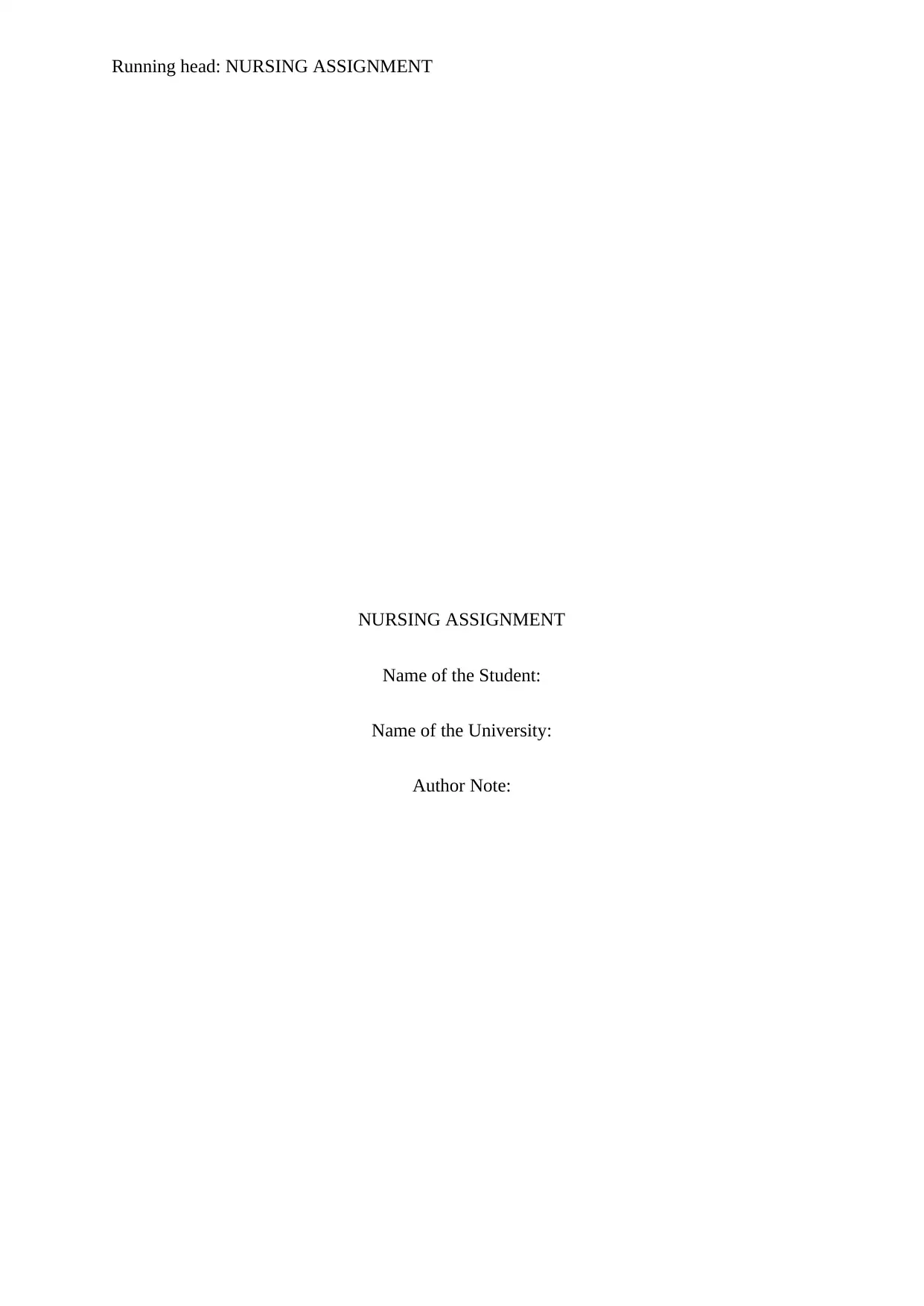
NURSING ASSIGNMENT
Name of the Student:
Name of the University:
Author Note:
Paraphrase This Document
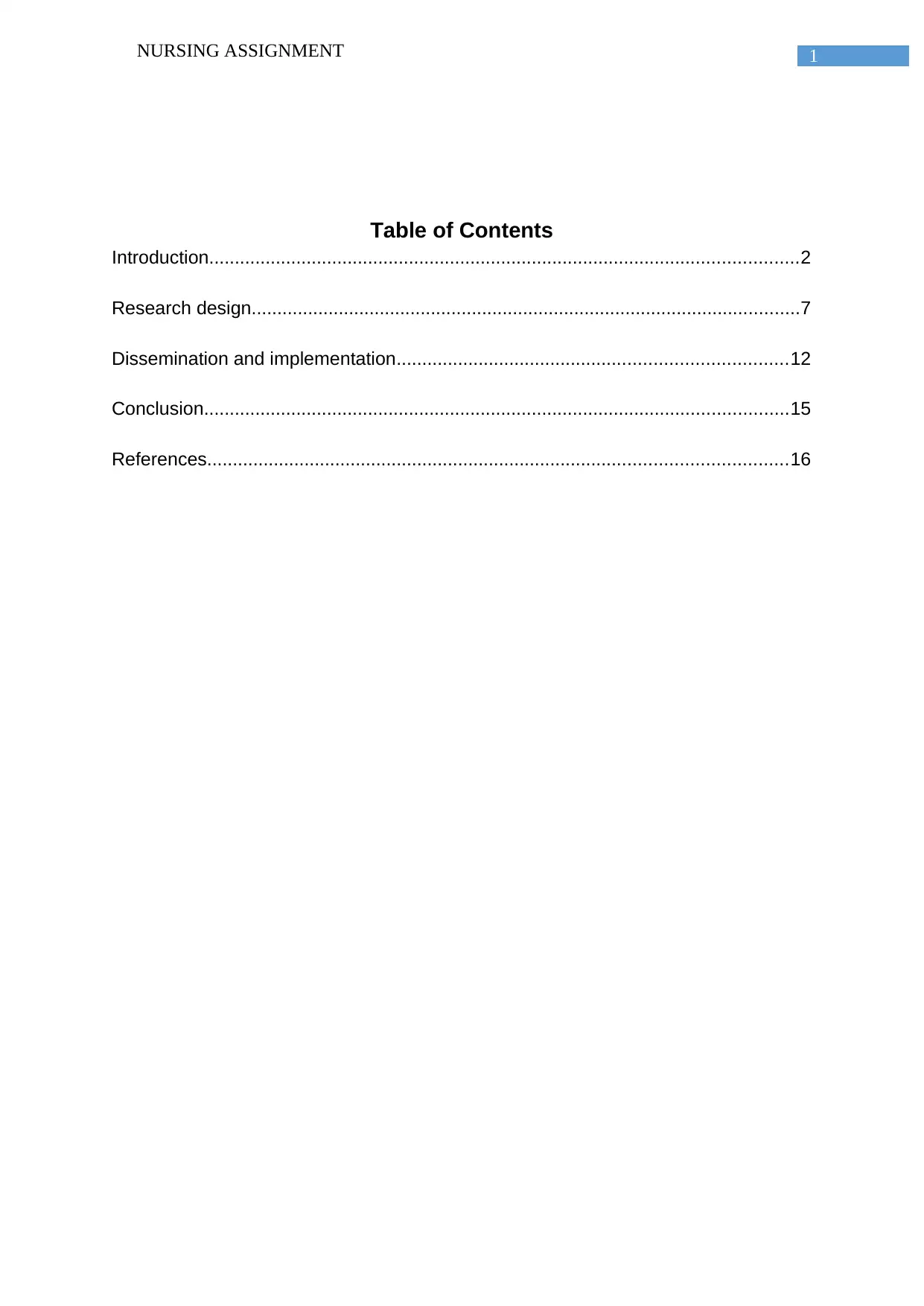
Table of Contents
Introduction...................................................................................................................2
Research design...........................................................................................................7
Dissemination and implementation............................................................................12
Conclusion..................................................................................................................15
References.................................................................................................................16
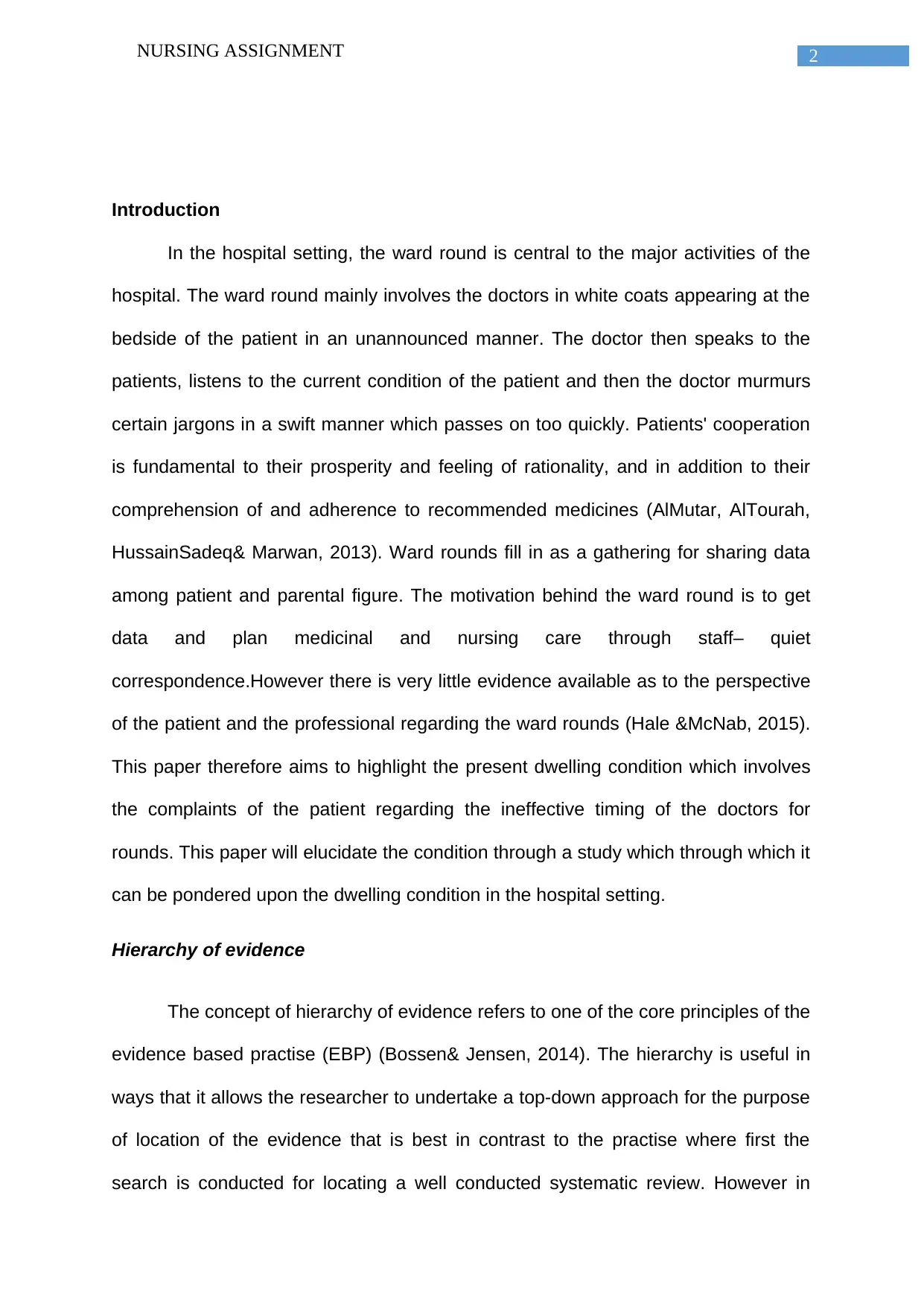
Introduction
In the hospital setting, the ward round is central to the major activities of the
hospital. The ward round mainly involves the doctors in white coats appearing at the
bedside of the patient in an unannounced manner. The doctor then speaks to the
patients, listens to the current condition of the patient and then the doctor murmurs
certain jargons in a swift manner which passes on too quickly. Patients' cooperation
is fundamental to their prosperity and feeling of rationality, and in addition to their
comprehension of and adherence to recommended medicines (AlMutar, AlTourah,
HussainSadeq& Marwan, 2013). Ward rounds fill in as a gathering for sharing data
among patient and parental figure. The motivation behind the ward round is to get
data and plan medicinal and nursing care through staff– quiet
correspondence.However there is very little evidence available as to the perspective
of the patient and the professional regarding the ward rounds (Hale &McNab, 2015).
This paper therefore aims to highlight the present dwelling condition which involves
the complaints of the patient regarding the ineffective timing of the doctors for
rounds. This paper will elucidate the condition through a study which through which it
can be pondered upon the dwelling condition in the hospital setting.
Hierarchy of evidence
The concept of hierarchy of evidence refers to one of the core principles of the
evidence based practise (EBP) (Bossen& Jensen, 2014). The hierarchy is useful in
ways that it allows the researcher to undertake a top-down approach for the purpose
of location of the evidence that is best in contrast to the practise where first the
search is conducted for locating a well conducted systematic review. However in
⊘ This is a preview!⊘
Do you want full access?
Subscribe today to unlock all pages.

Trusted by 1+ million students worldwide
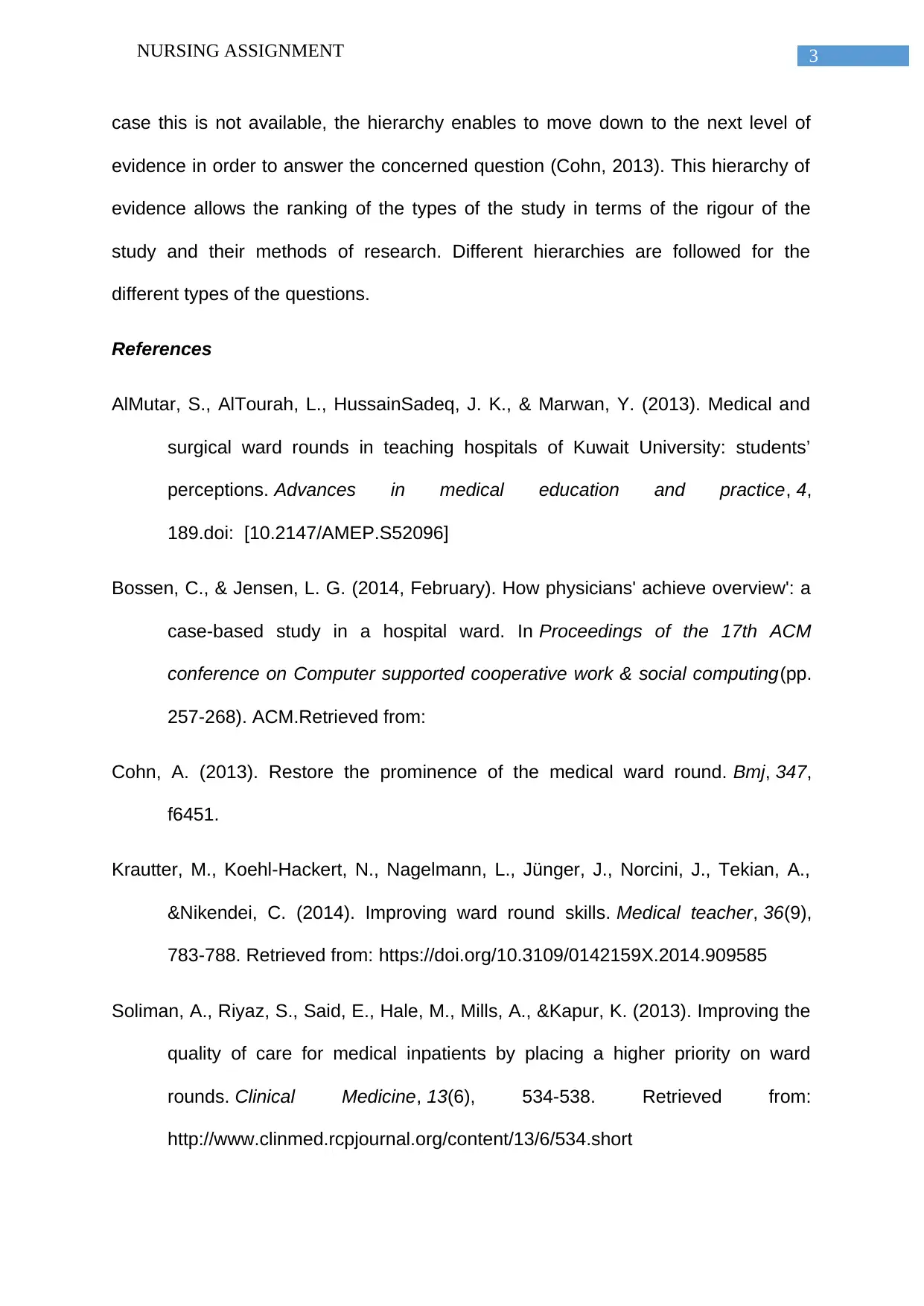
case this is not available, the hierarchy enables to move down to the next level of
evidence in order to answer the concerned question (Cohn, 2013). This hierarchy of
evidence allows the ranking of the types of the study in terms of the rigour of the
study and their methods of research. Different hierarchies are followed for the
different types of the questions.
References
AlMutar, S., AlTourah, L., HussainSadeq, J. K., & Marwan, Y. (2013). Medical and
surgical ward rounds in teaching hospitals of Kuwait University: students’
perceptions. Advances in medical education and practice, 4,
189.doi: [10.2147/AMEP.S52096]
Bossen, C., & Jensen, L. G. (2014, February). How physicians' achieve overview': a
case-based study in a hospital ward. In Proceedings of the 17th ACM
conference on Computer supported cooperative work & social computing(pp.
257-268). ACM.Retrieved from:
Cohn, A. (2013). Restore the prominence of the medical ward round. Bmj, 347,
f6451.
Krautter, M., Koehl-Hackert, N., Nagelmann, L., Jünger, J., Norcini, J., Tekian, A.,
&Nikendei, C. (2014). Improving ward round skills. Medical teacher, 36(9),
783-788. Retrieved from: https://doi.org/10.3109/0142159X.2014.909585
Soliman, A., Riyaz, S., Said, E., Hale, M., Mills, A., &Kapur, K. (2013). Improving the
quality of care for medical inpatients by placing a higher priority on ward
rounds. Clinical Medicine, 13(6), 534-538. Retrieved from:
http://www.clinmed.rcpjournal.org/content/13/6/534.short
Paraphrase This Document
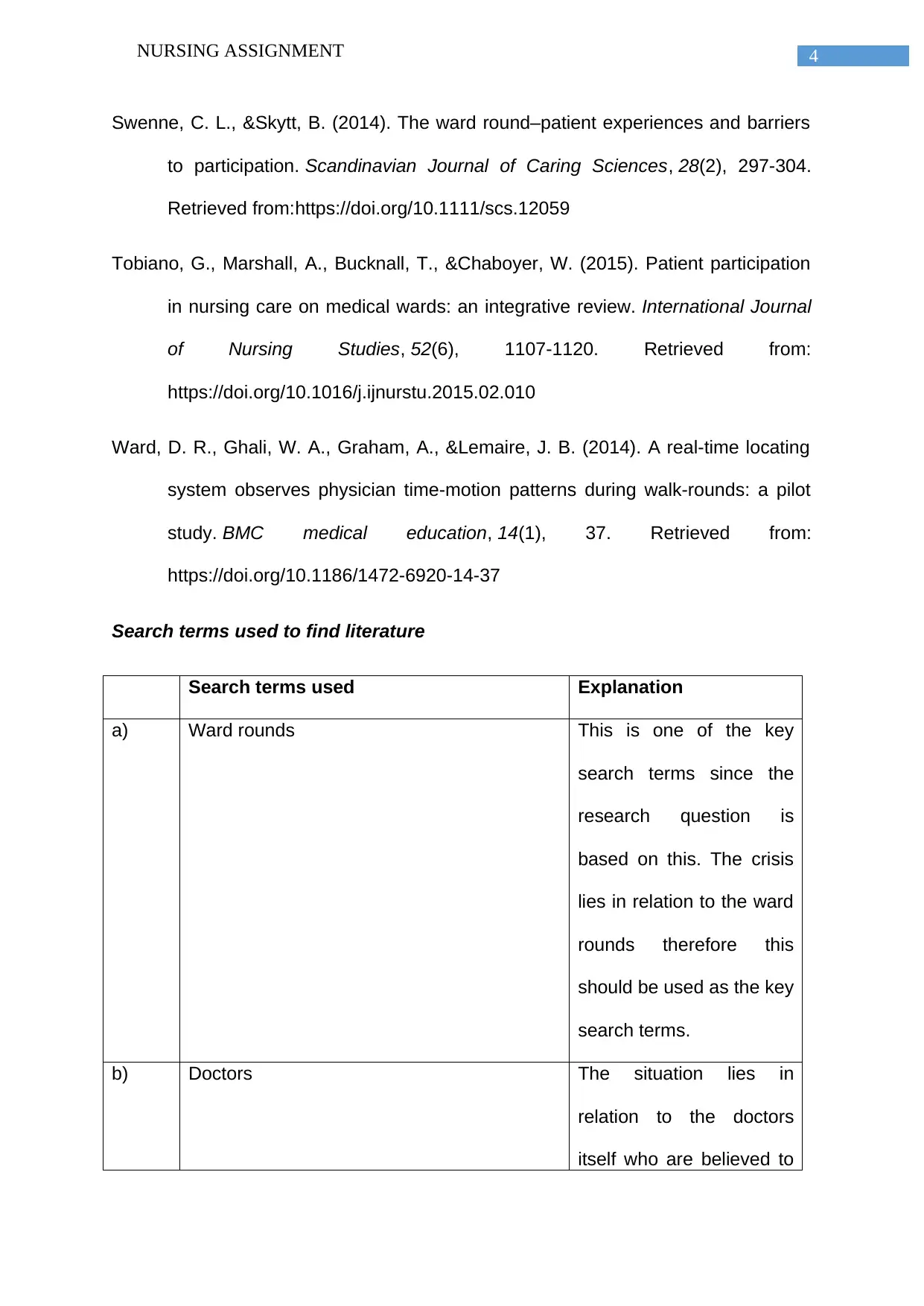
Swenne, C. L., &Skytt, B. (2014). The ward round–patient experiences and barriers
to participation. Scandinavian Journal of Caring Sciences, 28(2), 297-304.
Retrieved from:https://doi.org/10.1111/scs.12059
Tobiano, G., Marshall, A., Bucknall, T., &Chaboyer, W. (2015). Patient participation
in nursing care on medical wards: an integrative review. International Journal
of Nursing Studies, 52(6), 1107-1120. Retrieved from:
https://doi.org/10.1016/j.ijnurstu.2015.02.010
Ward, D. R., Ghali, W. A., Graham, A., &Lemaire, J. B. (2014). A real-time locating
system observes physician time-motion patterns during walk-rounds: a pilot
study. BMC medical education, 14(1), 37. Retrieved from:
https://doi.org/10.1186/1472-6920-14-37
Search terms used to find literature
Search terms used Explanation
a) Ward rounds This is one of the key
search terms since the
research question is
based on this. The crisis
lies in relation to the ward
rounds therefore this
should be used as the key
search terms.
b) Doctors The situation lies in
relation to the doctors
itself who are believed to
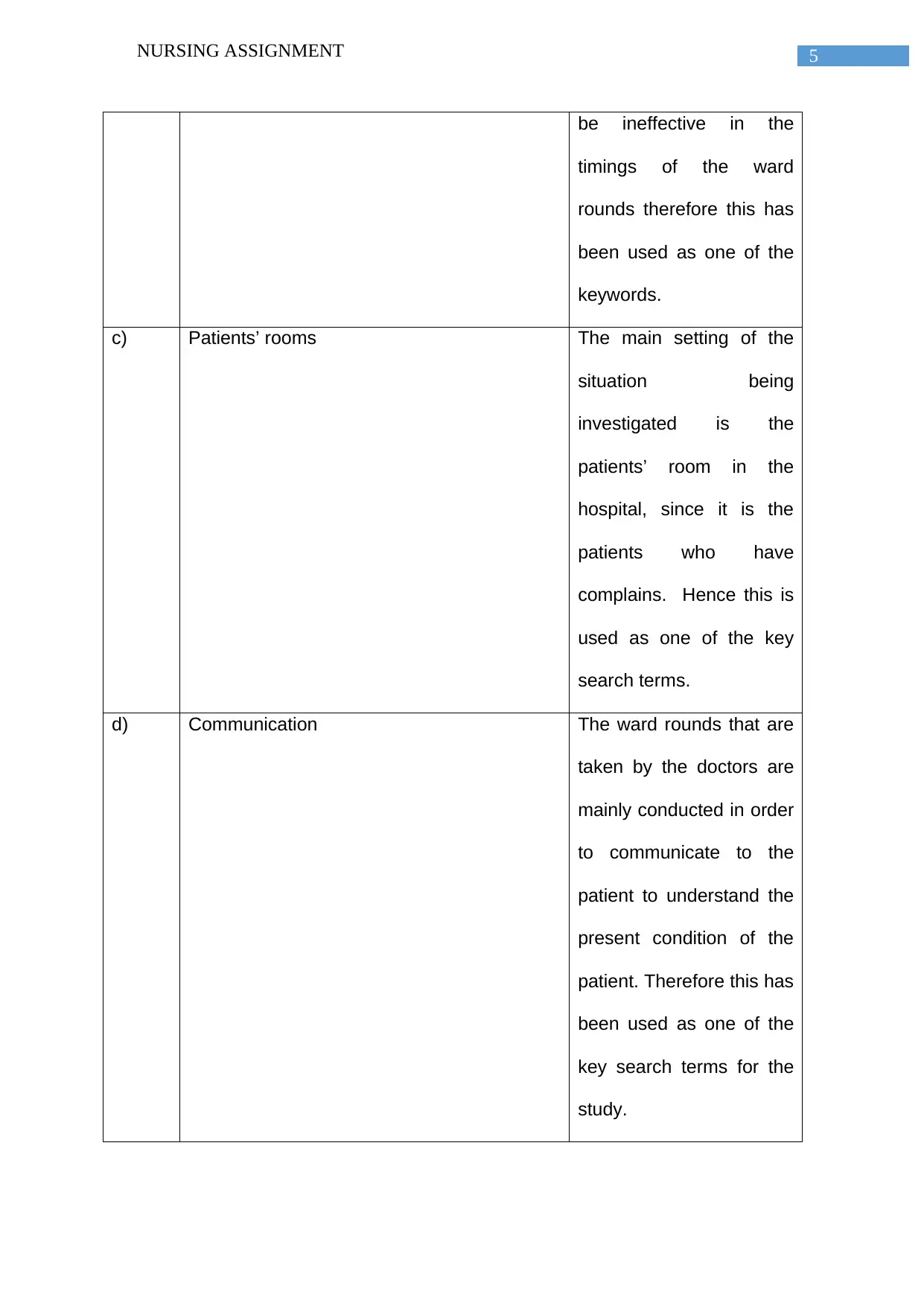
be ineffective in the
timings of the ward
rounds therefore this has
been used as one of the
keywords.
c) Patients’ rooms The main setting of the
situation being
investigated is the
patients’ room in the
hospital, since it is the
patients who have
complains. Hence this is
used as one of the key
search terms.
d) Communication The ward rounds that are
taken by the doctors are
mainly conducted in order
to communicate to the
patient to understand the
present condition of the
patient. Therefore this has
been used as one of the
key search terms for the
study.
⊘ This is a preview!⊘
Do you want full access?
Subscribe today to unlock all pages.

Trusted by 1+ million students worldwide
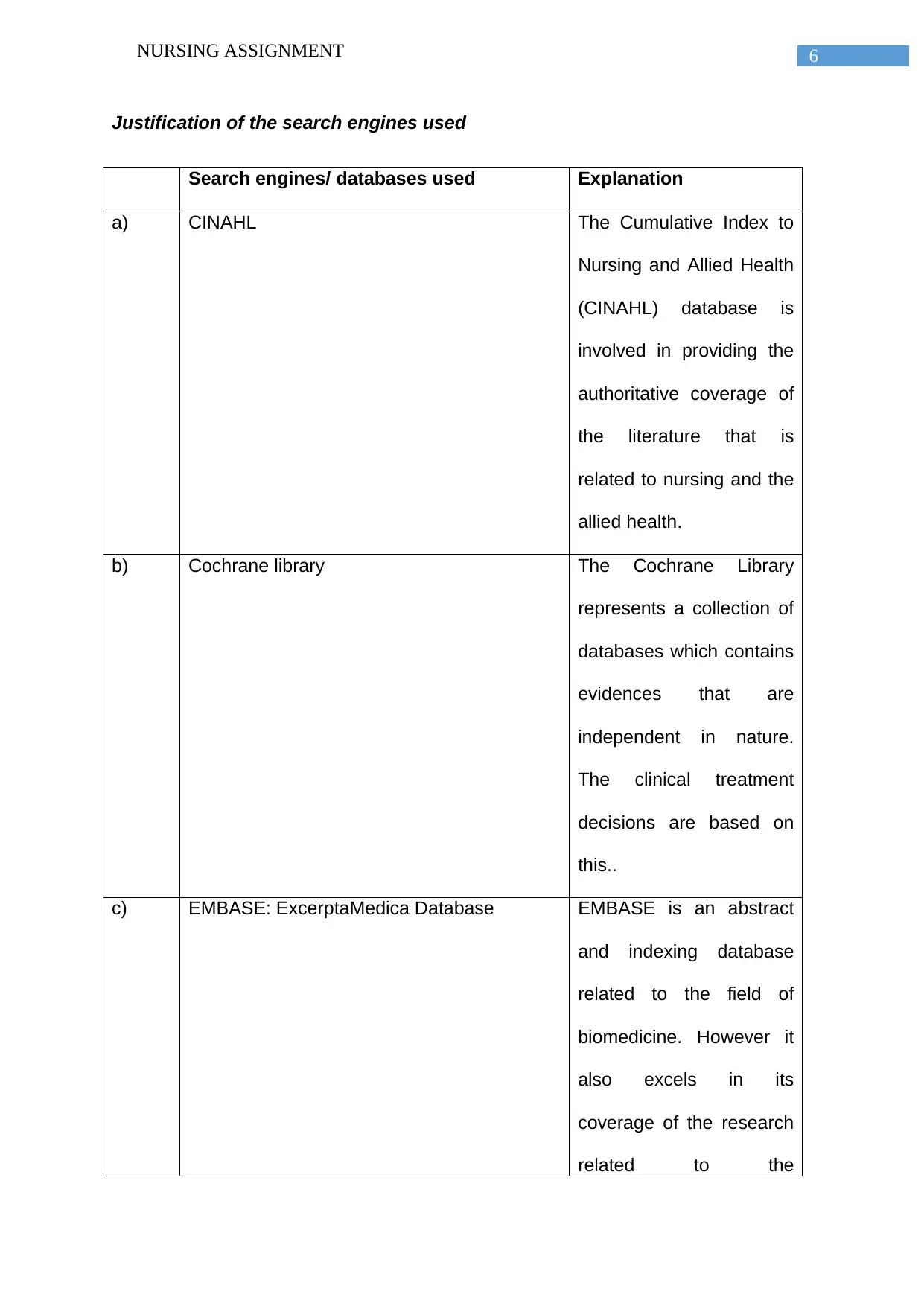
Justification of the search engines used
Search engines/ databases used Explanation
a) CINAHL The Cumulative Index to
Nursing and Allied Health
(CINAHL) database is
involved in providing the
authoritative coverage of
the literature that is
related to nursing and the
allied health.
b) Cochrane library The Cochrane Library
represents a collection of
databases which contains
evidences that are
independent in nature.
The clinical treatment
decisions are based on
this..
c) EMBASE: ExcerptaMedica Database EMBASE is an abstract
and indexing database
related to the field of
biomedicine. However it
also excels in its
coverage of the research
related to the
Paraphrase This Document
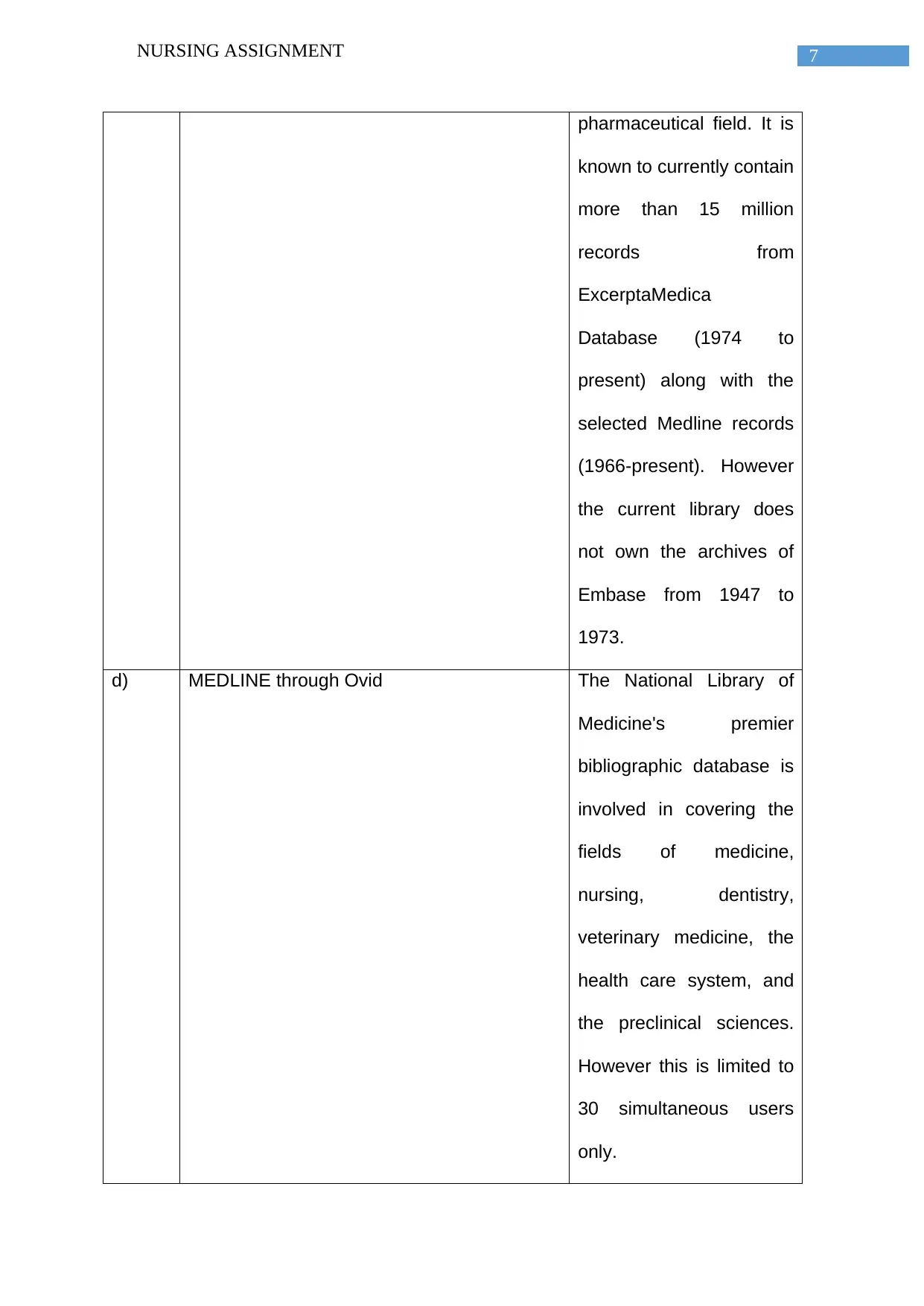
pharmaceutical field. It is
known to currently contain
more than 15 million
records from
ExcerptaMedica
Database (1974 to
present) along with the
selected Medline records
(1966-present). However
the current library does
not own the archives of
Embase from 1947 to
1973.
d) MEDLINE through Ovid The National Library of
Medicine's premier
bibliographic database is
involved in covering the
fields of medicine,
nursing, dentistry,
veterinary medicine, the
health care system, and
the preclinical sciences.
However this is limited to
30 simultaneous users
only.
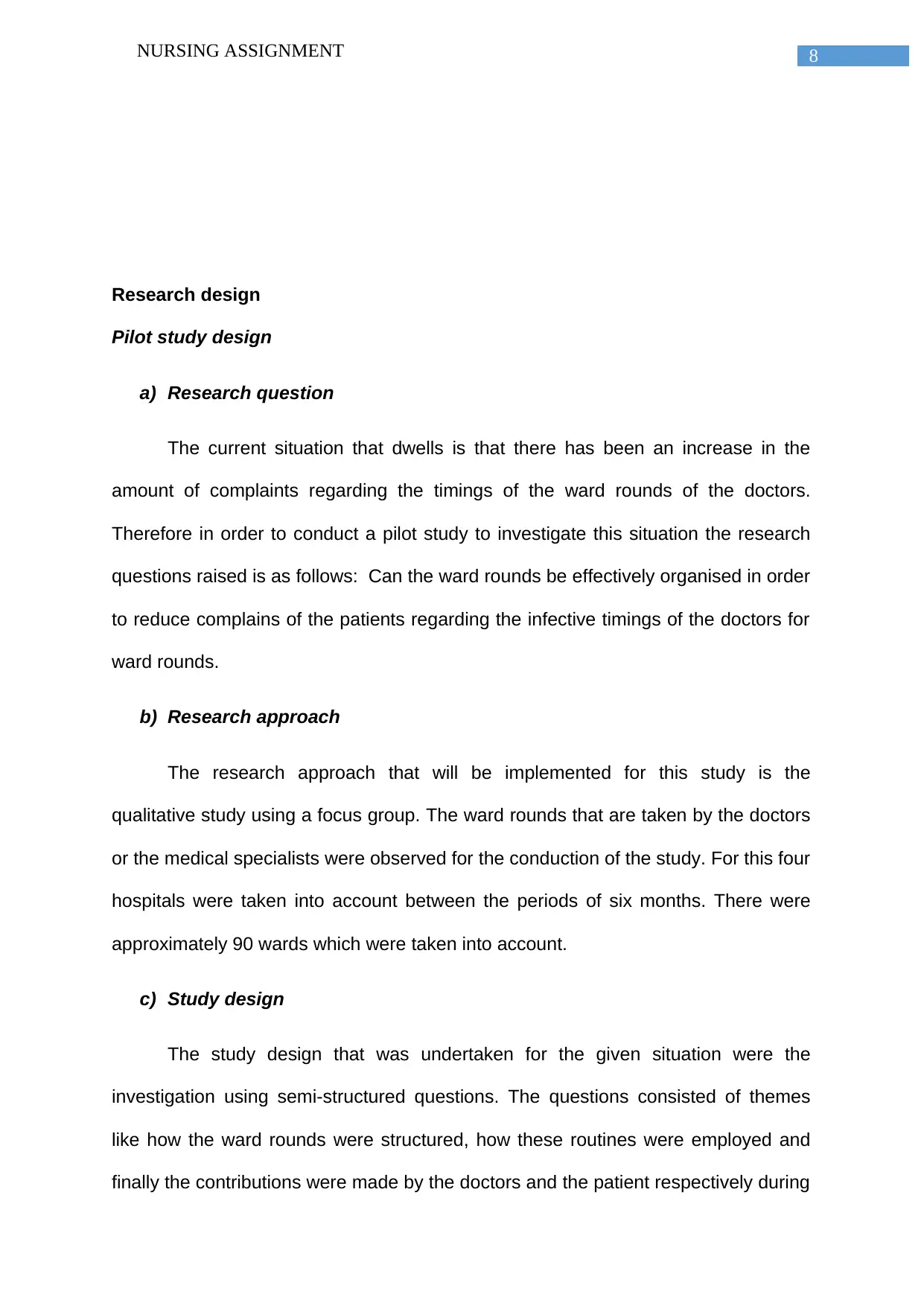
Research design
Pilot study design
a) Research question
The current situation that dwells is that there has been an increase in the
amount of complaints regarding the timings of the ward rounds of the doctors.
Therefore in order to conduct a pilot study to investigate this situation the research
questions raised is as follows: Can the ward rounds be effectively organised in order
to reduce complains of the patients regarding the infective timings of the doctors for
ward rounds.
b) Research approach
The research approach that will be implemented for this study is the
qualitative study using a focus group. The ward rounds that are taken by the doctors
or the medical specialists were observed for the conduction of the study. For this four
hospitals were taken into account between the periods of six months. There were
approximately 90 wards which were taken into account.
c) Study design
The study design that was undertaken for the given situation were the
investigation using semi-structured questions. The questions consisted of themes
like how the ward rounds were structured, how these routines were employed and
finally the contributions were made by the doctors and the patient respectively during
⊘ This is a preview!⊘
Do you want full access?
Subscribe today to unlock all pages.

Trusted by 1+ million students worldwide
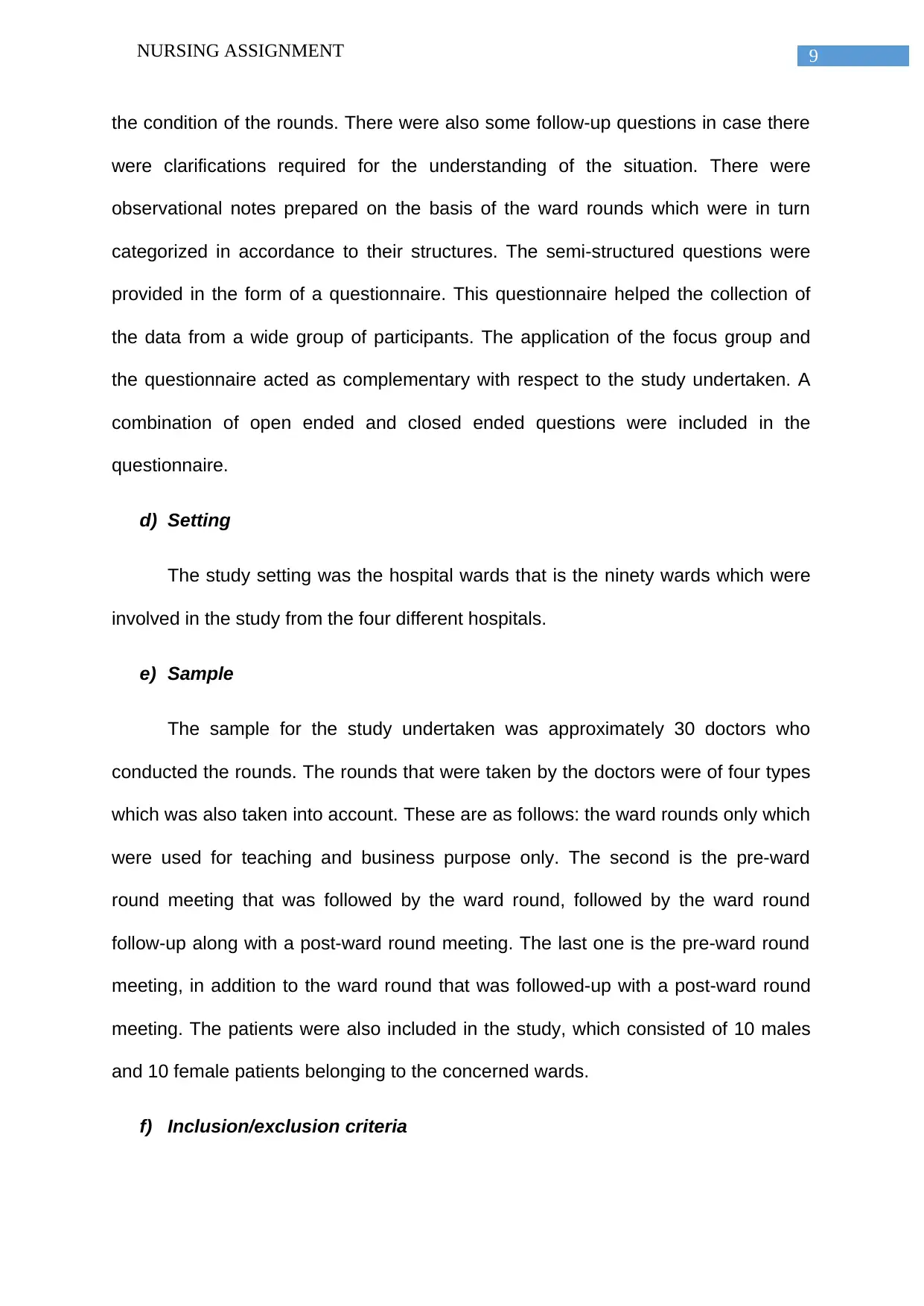
the condition of the rounds. There were also some follow-up questions in case there
were clarifications required for the understanding of the situation. There were
observational notes prepared on the basis of the ward rounds which were in turn
categorized in accordance to their structures. The semi-structured questions were
provided in the form of a questionnaire. This questionnaire helped the collection of
the data from a wide group of participants. The application of the focus group and
the questionnaire acted as complementary with respect to the study undertaken. A
combination of open ended and closed ended questions were included in the
questionnaire.
d) Setting
The study setting was the hospital wards that is the ninety wards which were
involved in the study from the four different hospitals.
e) Sample
The sample for the study undertaken was approximately 30 doctors who
conducted the rounds. The rounds that were taken by the doctors were of four types
which was also taken into account. These are as follows: the ward rounds only which
were used for teaching and business purpose only. The second is the pre-ward
round meeting that was followed by the ward round, followed by the ward round
follow-up along with a post-ward round meeting. The last one is the pre-ward round
meeting, in addition to the ward round that was followed-up with a post-ward round
meeting. The patients were also included in the study, which consisted of 10 males
and 10 female patients belonging to the concerned wards.
f) Inclusion/exclusion criteria
Paraphrase This Document
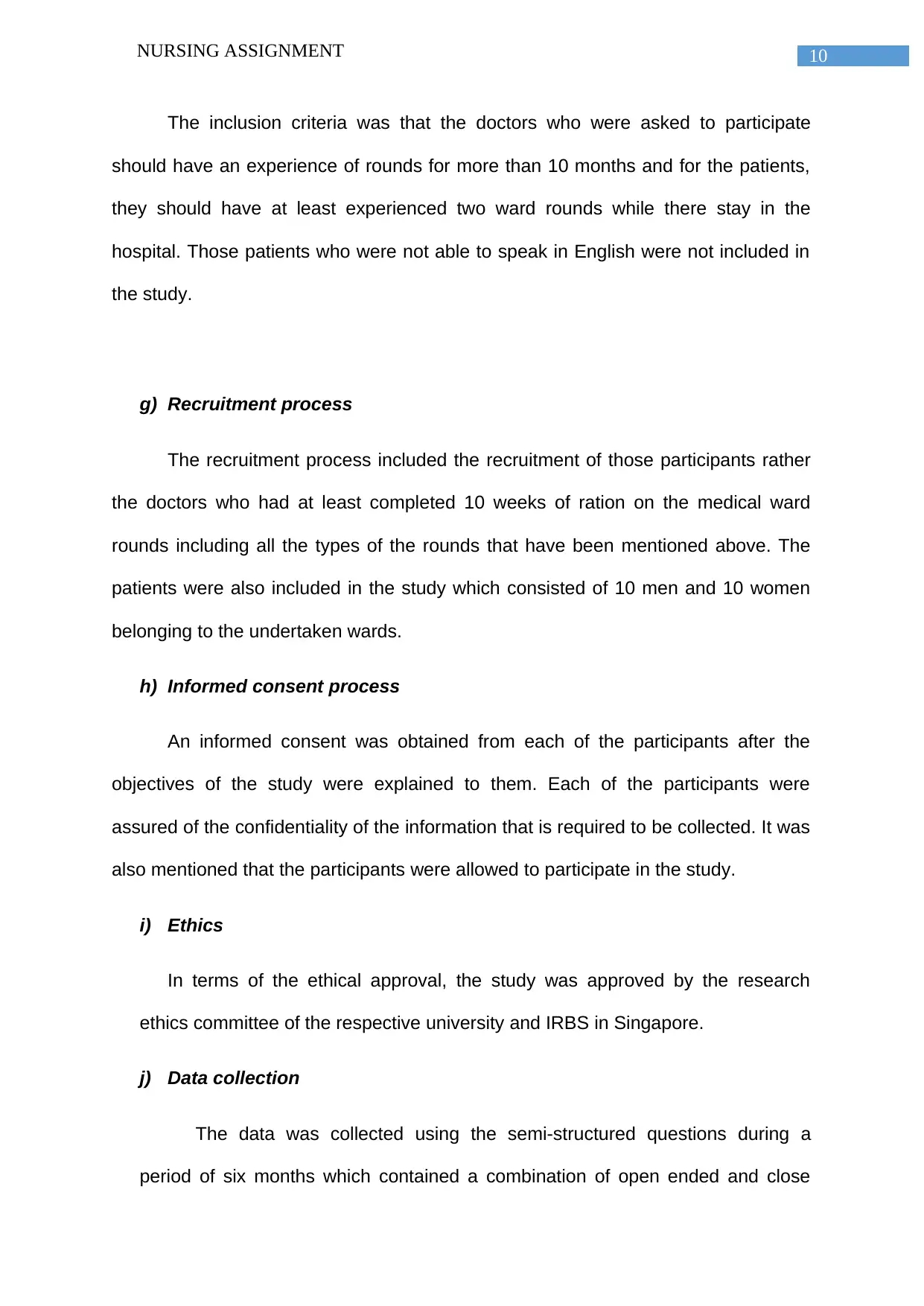
The inclusion criteria was that the doctors who were asked to participate
should have an experience of rounds for more than 10 months and for the patients,
they should have at least experienced two ward rounds while there stay in the
hospital. Those patients who were not able to speak in English were not included in
the study.
g) Recruitment process
The recruitment process included the recruitment of those participants rather
the doctors who had at least completed 10 weeks of ration on the medical ward
rounds including all the types of the rounds that have been mentioned above. The
patients were also included in the study which consisted of 10 men and 10 women
belonging to the undertaken wards.
h) Informed consent process
An informed consent was obtained from each of the participants after the
objectives of the study were explained to them. Each of the participants were
assured of the confidentiality of the information that is required to be collected. It was
also mentioned that the participants were allowed to participate in the study.
i) Ethics
In terms of the ethical approval, the study was approved by the research
ethics committee of the respective university and IRBS in Singapore.
j) Data collection
The data was collected using the semi-structured questions during a
period of six months which contained a combination of open ended and close
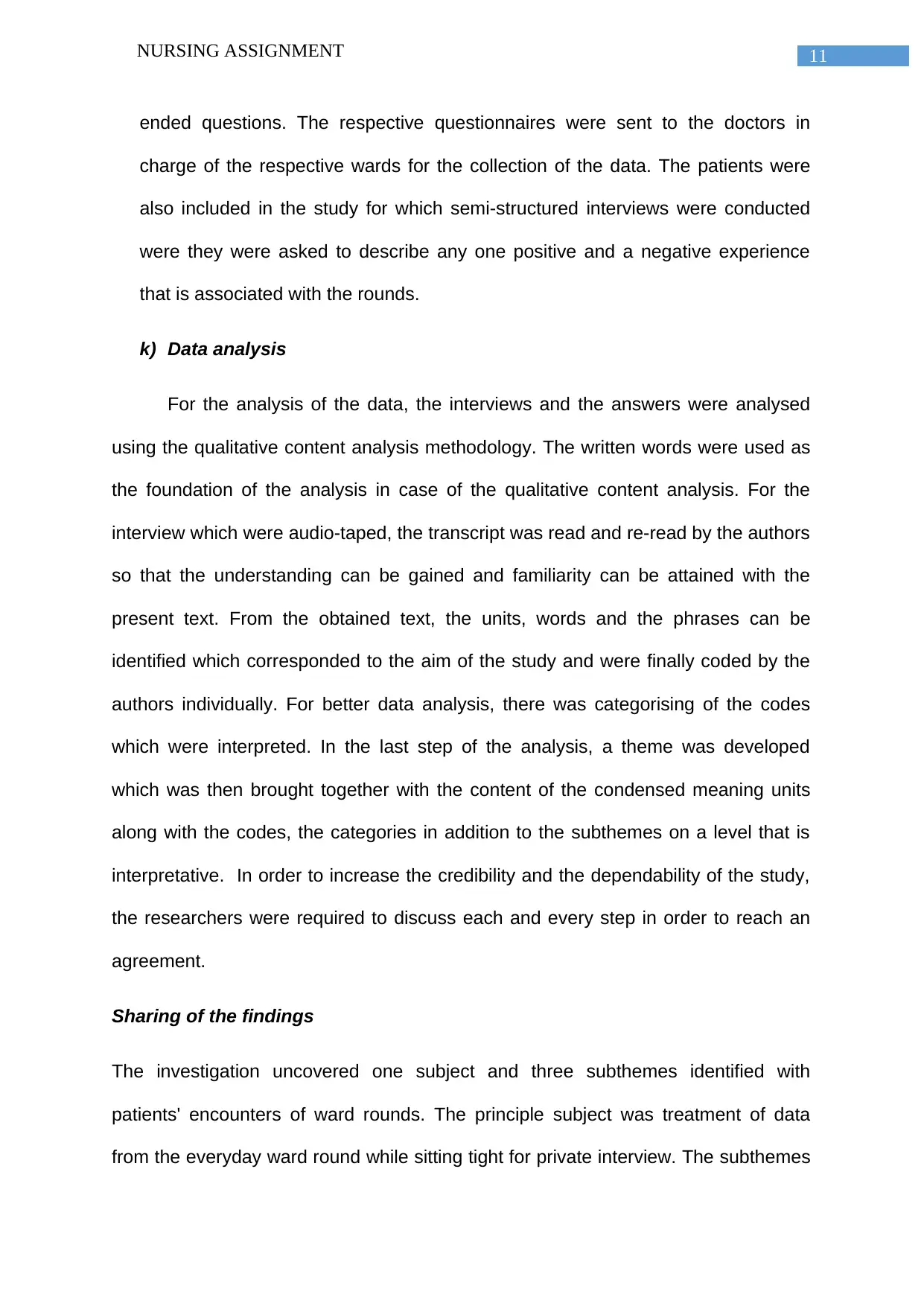
ended questions. The respective questionnaires were sent to the doctors in
charge of the respective wards for the collection of the data. The patients were
also included in the study for which semi-structured interviews were conducted
were they were asked to describe any one positive and a negative experience
that is associated with the rounds.
k) Data analysis
For the analysis of the data, the interviews and the answers were analysed
using the qualitative content analysis methodology. The written words were used as
the foundation of the analysis in case of the qualitative content analysis. For the
interview which were audio-taped, the transcript was read and re-read by the authors
so that the understanding can be gained and familiarity can be attained with the
present text. From the obtained text, the units, words and the phrases can be
identified which corresponded to the aim of the study and were finally coded by the
authors individually. For better data analysis, there was categorising of the codes
which were interpreted. In the last step of the analysis, a theme was developed
which was then brought together with the content of the condensed meaning units
along with the codes, the categories in addition to the subthemes on a level that is
interpretative. In order to increase the credibility and the dependability of the study,
the researchers were required to discuss each and every step in order to reach an
agreement.
Sharing of the findings
The investigation uncovered one subject and three subthemes identified with
patients' encounters of ward rounds. The principle subject was treatment of data
from the everyday ward round while sitting tight for private interview. The subthemes
⊘ This is a preview!⊘
Do you want full access?
Subscribe today to unlock all pages.

Trusted by 1+ million students worldwide
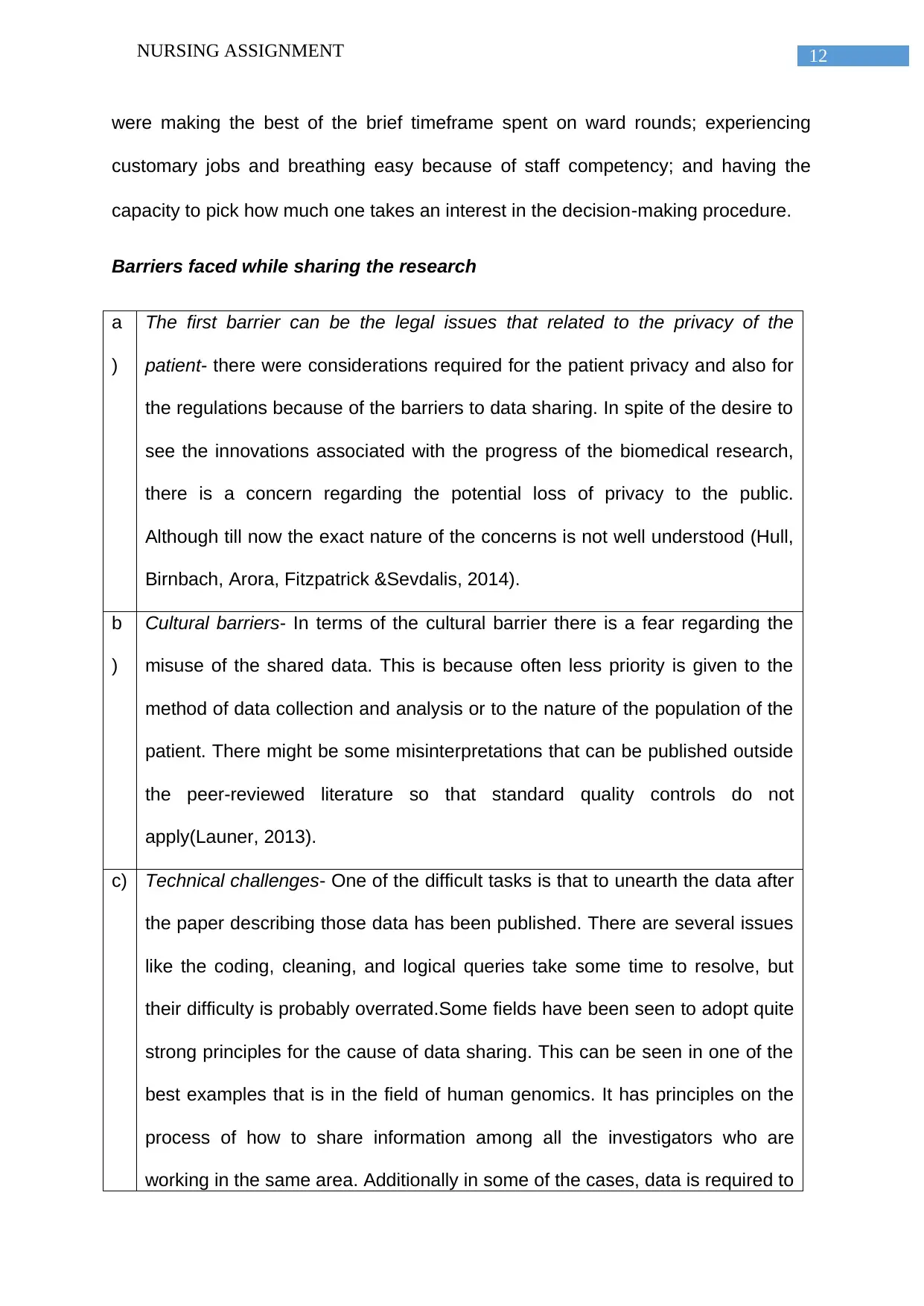
were making the best of the brief timeframe spent on ward rounds; experiencing
customary jobs and breathing easy because of staff competency; and having the
capacity to pick how much one takes an interest in the decision‐making procedure.
Barriers faced while sharing the research
a
)
The first barrier can be the legal issues that related to the privacy of the
patient- there were considerations required for the patient privacy and also for
the regulations because of the barriers to data sharing. In spite of the desire to
see the innovations associated with the progress of the biomedical research,
there is a concern regarding the potential loss of privacy to the public.
Although till now the exact nature of the concerns is not well understood (Hull,
Birnbach, Arora, Fitzpatrick &Sevdalis, 2014).
b
)
Cultural barriers- In terms of the cultural barrier there is a fear regarding the
misuse of the shared data. This is because often less priority is given to the
method of data collection and analysis or to the nature of the population of the
patient. There might be some misinterpretations that can be published outside
the peer-reviewed literature so that standard quality controls do not
apply(Launer, 2013).
c) Technical challenges- One of the difficult tasks is that to unearth the data after
the paper describing those data has been published. There are several issues
like the coding, cleaning, and logical queries take some time to resolve, but
their difficulty is probably overrated.Some fields have been seen to adopt quite
strong principles for the cause of data sharing. This can be seen in one of the
best examples that is in the field of human genomics. It has principles on the
process of how to share information among all the investigators who are
working in the same area. Additionally in some of the cases, data is required to
Paraphrase This Document
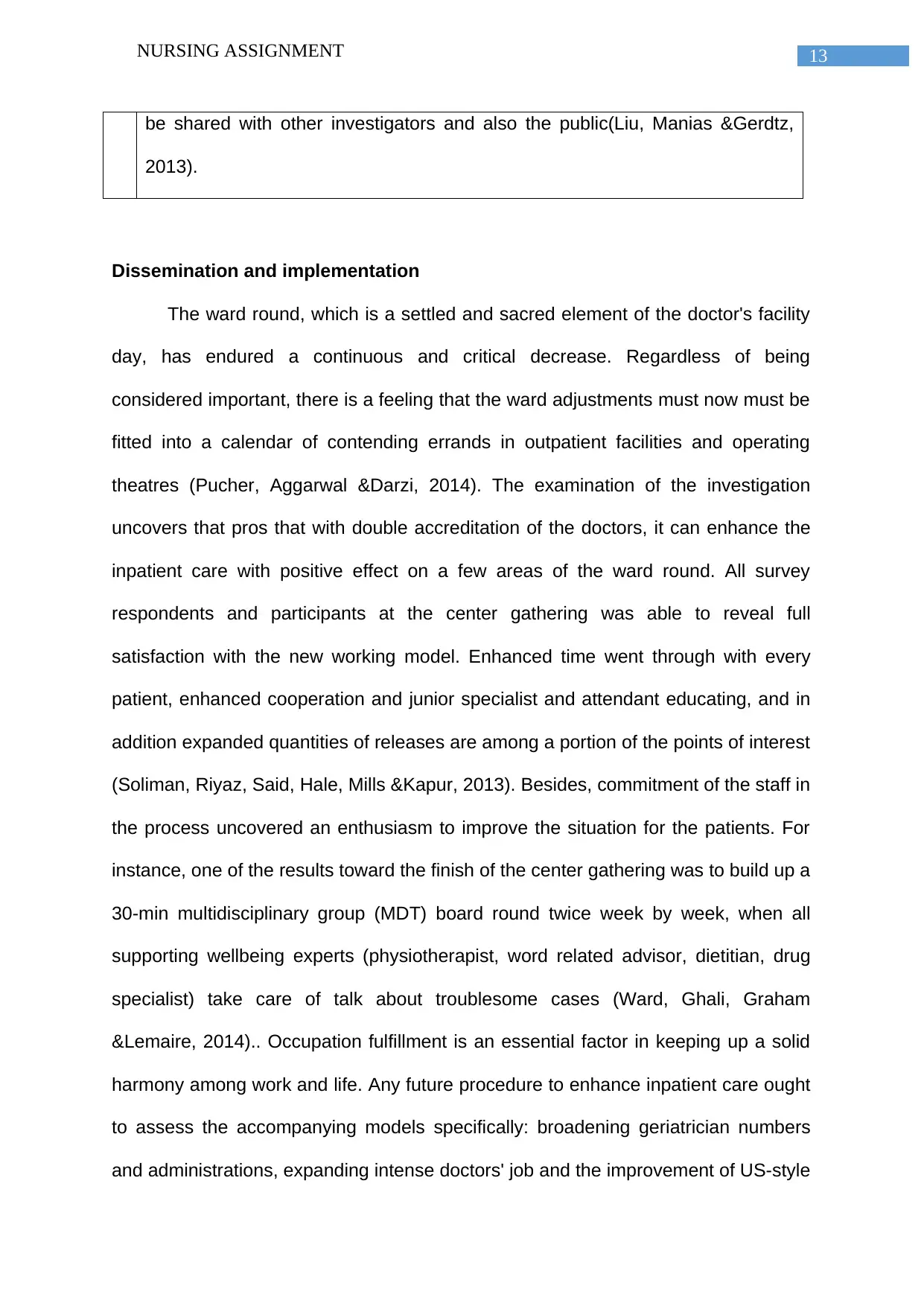
be shared with other investigators and also the public(Liu, Manias &Gerdtz,
2013).
Dissemination and implementation
The ward round, which is a settled and sacred element of the doctor's facility
day, has endured a continuous and critical decrease. Regardless of being
considered important, there is a feeling that the ward adjustments must now must be
fitted into a calendar of contending errands in outpatient facilities and operating
theatres (Pucher, Aggarwal &Darzi, 2014). The examination of the investigation
uncovers that pros that with double accreditation of the doctors, it can enhance the
inpatient care with positive effect on a few areas of the ward round. All survey
respondents and participants at the center gathering was able to reveal full
satisfaction with the new working model. Enhanced time went through with every
patient, enhanced cooperation and junior specialist and attendant educating, and in
addition expanded quantities of releases are among a portion of the points of interest
(Soliman, Riyaz, Said, Hale, Mills &Kapur, 2013). Besides, commitment of the staff in
the process uncovered an enthusiasm to improve the situation for the patients. For
instance, one of the results toward the finish of the center gathering was to build up a
30-min multidisciplinary group (MDT) board round twice week by week, when all
supporting wellbeing experts (physiotherapist, word related advisor, dietitian, drug
specialist) take care of talk about troublesome cases (Ward, Ghali, Graham
&Lemaire, 2014).. Occupation fulfillment is an essential factor in keeping up a solid
harmony among work and life. Any future procedure to enhance inpatient care ought
to assess the accompanying models specifically: broadening geriatrician numbers
and administrations, expanding intense doctors' job and the improvement of US-style
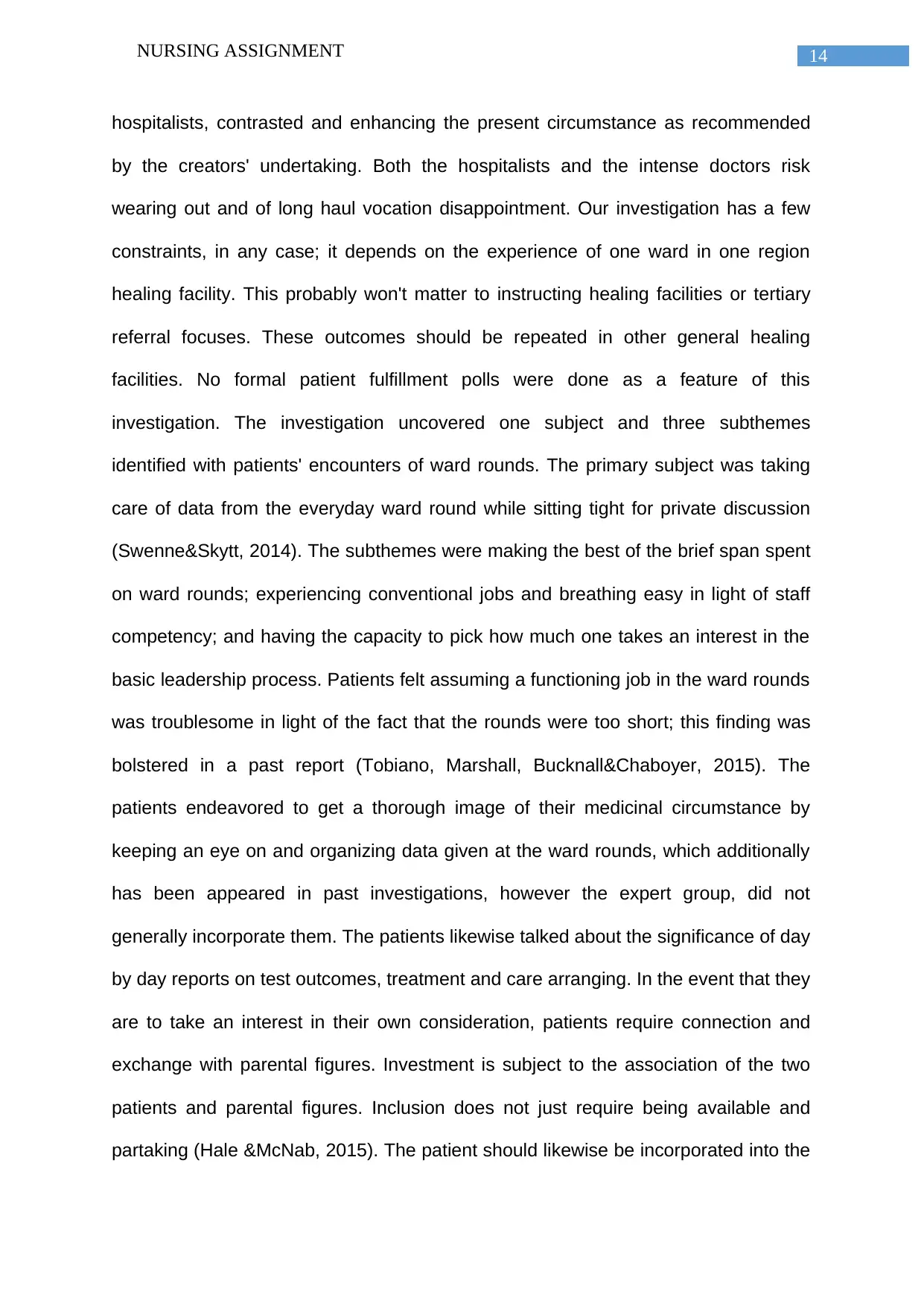
hospitalists, contrasted and enhancing the present circumstance as recommended
by the creators' undertaking. Both the hospitalists and the intense doctors risk
wearing out and of long haul vocation disappointment. Our investigation has a few
constraints, in any case; it depends on the experience of one ward in one region
healing facility. This probably won't matter to instructing healing facilities or tertiary
referral focuses. These outcomes should be repeated in other general healing
facilities. No formal patient fulfillment polls were done as a feature of this
investigation. The investigation uncovered one subject and three subthemes
identified with patients' encounters of ward rounds. The primary subject was taking
care of data from the everyday ward round while sitting tight for private discussion
(Swenne&Skytt, 2014). The subthemes were making the best of the brief span spent
on ward rounds; experiencing conventional jobs and breathing easy in light of staff
competency; and having the capacity to pick how much one takes an interest in the
basic leadership process. Patients felt assuming a functioning job in the ward rounds
was troublesome in light of the fact that the rounds were too short; this finding was
bolstered in a past report (Tobiano, Marshall, Bucknall&Chaboyer, 2015). The
patients endeavored to get a thorough image of their medicinal circumstance by
keeping an eye on and organizing data given at the ward rounds, which additionally
has been appeared in past investigations, however the expert group, did not
generally incorporate them. The patients likewise talked about the significance of day
by day reports on test outcomes, treatment and care arranging. In the event that they
are to take an interest in their own consideration, patients require connection and
exchange with parental figures. Investment is subject to the association of the two
patients and parental figures. Inclusion does not just require being available and
partaking (Hale &McNab, 2015). The patient should likewise be incorporated into the
⊘ This is a preview!⊘
Do you want full access?
Subscribe today to unlock all pages.

Trusted by 1+ million students worldwide
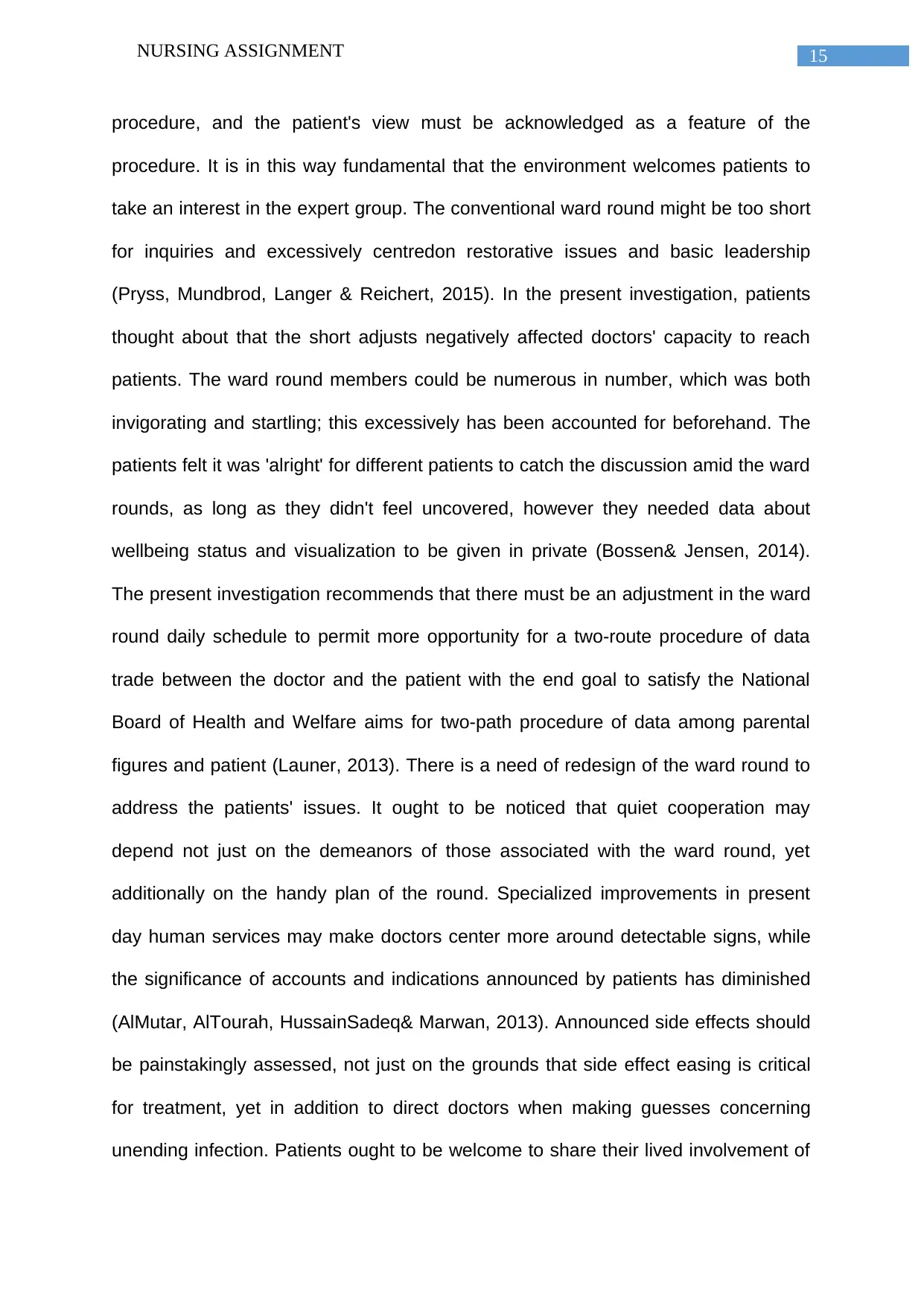
procedure, and the patient's view must be acknowledged as a feature of the
procedure. It is in this way fundamental that the environment welcomes patients to
take an interest in the expert group. The conventional ward round might be too short
for inquiries and excessively centredon restorative issues and basic leadership
(Pryss, Mundbrod, Langer & Reichert, 2015). In the present investigation, patients
thought about that the short adjusts negatively affected doctors' capacity to reach
patients. The ward round members could be numerous in number, which was both
invigorating and startling; this excessively has been accounted for beforehand. The
patients felt it was 'alright' for different patients to catch the discussion amid the ward
rounds, as long as they didn't feel uncovered, however they needed data about
wellbeing status and visualization to be given in private (Bossen& Jensen, 2014).
The present investigation recommends that there must be an adjustment in the ward
round daily schedule to permit more opportunity for a two-route procedure of data
trade between the doctor and the patient with the end goal to satisfy the National
Board of Health and Welfare aims for two-path procedure of data among parental
figures and patient (Launer, 2013). There is a need of redesign of the ward round to
address the patients' issues. It ought to be noticed that quiet cooperation may
depend not just on the demeanors of those associated with the ward round, yet
additionally on the handy plan of the round. Specialized improvements in present
day human services may make doctors center more around detectable signs, while
the significance of accounts and indications announced by patients has diminished
(AlMutar, AlTourah, HussainSadeq& Marwan, 2013). Announced side effects should
be painstakingly assessed, not just on the grounds that side effect easing is critical
for treatment, yet in addition to direct doctors when making guesses concerning
unending infection. Patients ought to be welcome to share their lived involvement of
Paraphrase This Document
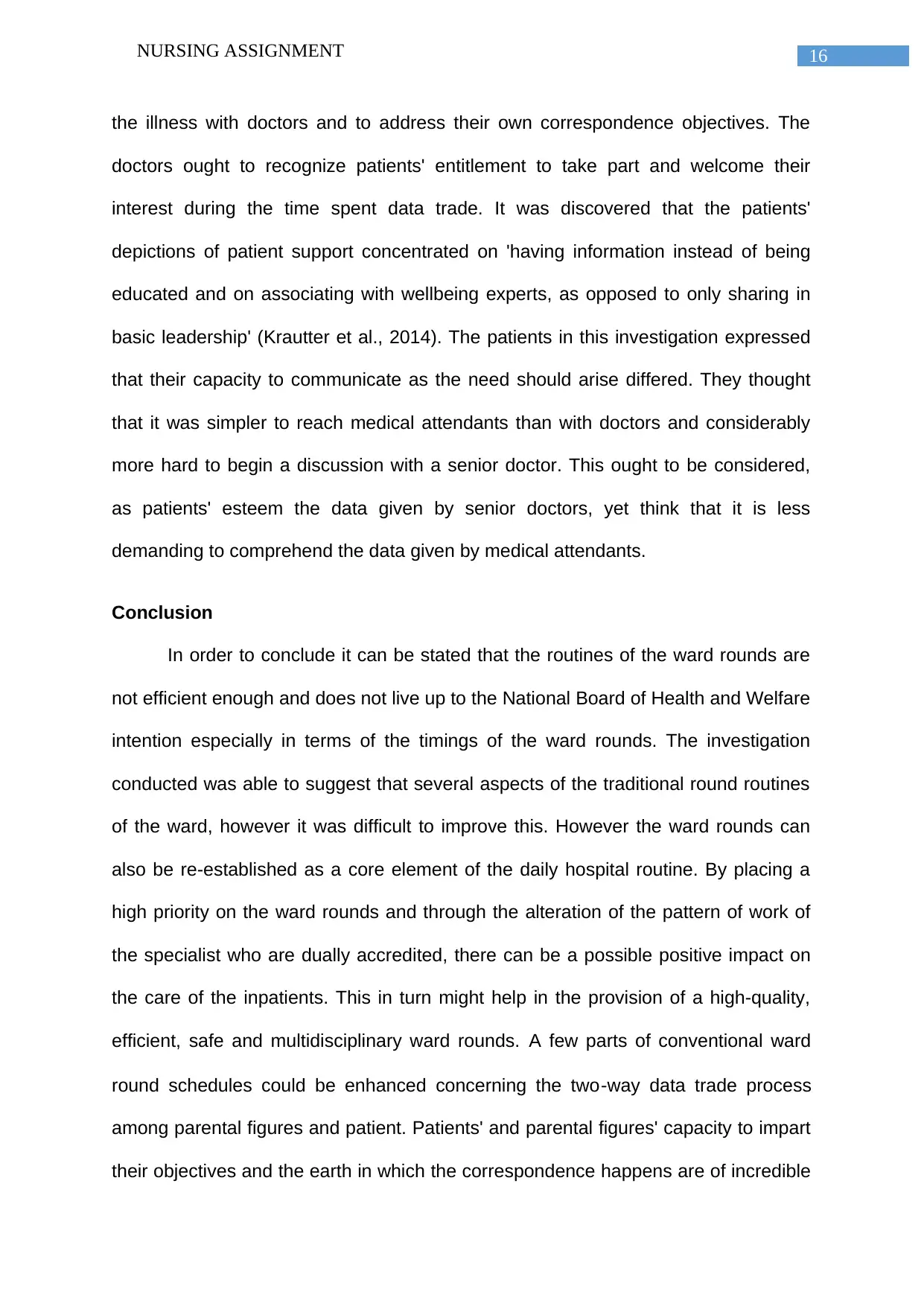
the illness with doctors and to address their own correspondence objectives. The
doctors ought to recognize patients' entitlement to take part and welcome their
interest during the time spent data trade. It was discovered that the patients'
depictions of patient support concentrated on 'having information instead of being
educated and on associating with wellbeing experts, as opposed to only sharing in
basic leadership' (Krautter et al., 2014). The patients in this investigation expressed
that their capacity to communicate as the need should arise differed. They thought
that it was simpler to reach medical attendants than with doctors and considerably
more hard to begin a discussion with a senior doctor. This ought to be considered,
as patients' esteem the data given by senior doctors, yet think that it is less
demanding to comprehend the data given by medical attendants.
Conclusion
In order to conclude it can be stated that the routines of the ward rounds are
not efficient enough and does not live up to the National Board of Health and Welfare
intention especially in terms of the timings of the ward rounds. The investigation
conducted was able to suggest that several aspects of the traditional round routines
of the ward, however it was difficult to improve this. However the ward rounds can
also be re-established as a core element of the daily hospital routine. By placing a
high priority on the ward rounds and through the alteration of the pattern of work of
the specialist who are dually accredited, there can be a possible positive impact on
the care of the inpatients. This in turn might help in the provision of a high-quality,
efficient, safe and multidisciplinary ward rounds. A few parts of conventional ward
round schedules could be enhanced concerning the two‐way data trade process
among parental figures and patient. Patients' and parental figures' capacity to impart
their objectives and the earth in which the correspondence happens are of incredible
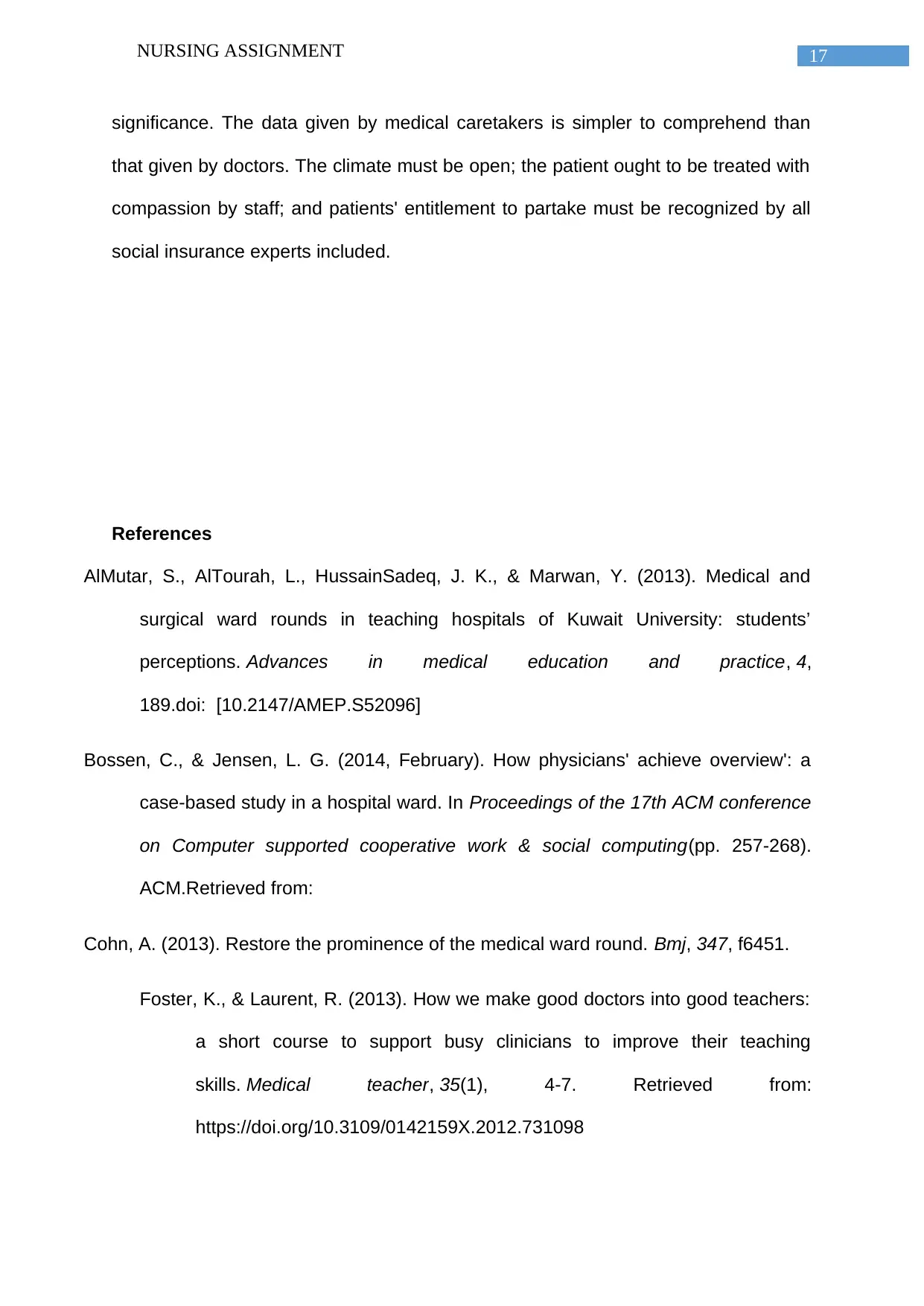
significance. The data given by medical caretakers is simpler to comprehend than
that given by doctors. The climate must be open; the patient ought to be treated with
compassion by staff; and patients' entitlement to partake must be recognized by all
social insurance experts included.
References
AlMutar, S., AlTourah, L., HussainSadeq, J. K., & Marwan, Y. (2013). Medical and
surgical ward rounds in teaching hospitals of Kuwait University: students’
perceptions. Advances in medical education and practice, 4,
189.doi: [10.2147/AMEP.S52096]
Bossen, C., & Jensen, L. G. (2014, February). How physicians' achieve overview': a
case-based study in a hospital ward. In Proceedings of the 17th ACM conference
on Computer supported cooperative work & social computing(pp. 257-268).
ACM.Retrieved from:
Cohn, A. (2013). Restore the prominence of the medical ward round. Bmj, 347, f6451.
Foster, K., & Laurent, R. (2013). How we make good doctors into good teachers:
a short course to support busy clinicians to improve their teaching
skills. Medical teacher, 35(1), 4-7. Retrieved from:
https://doi.org/10.3109/0142159X.2012.731098
⊘ This is a preview!⊘
Do you want full access?
Subscribe today to unlock all pages.

Trusted by 1+ million students worldwide
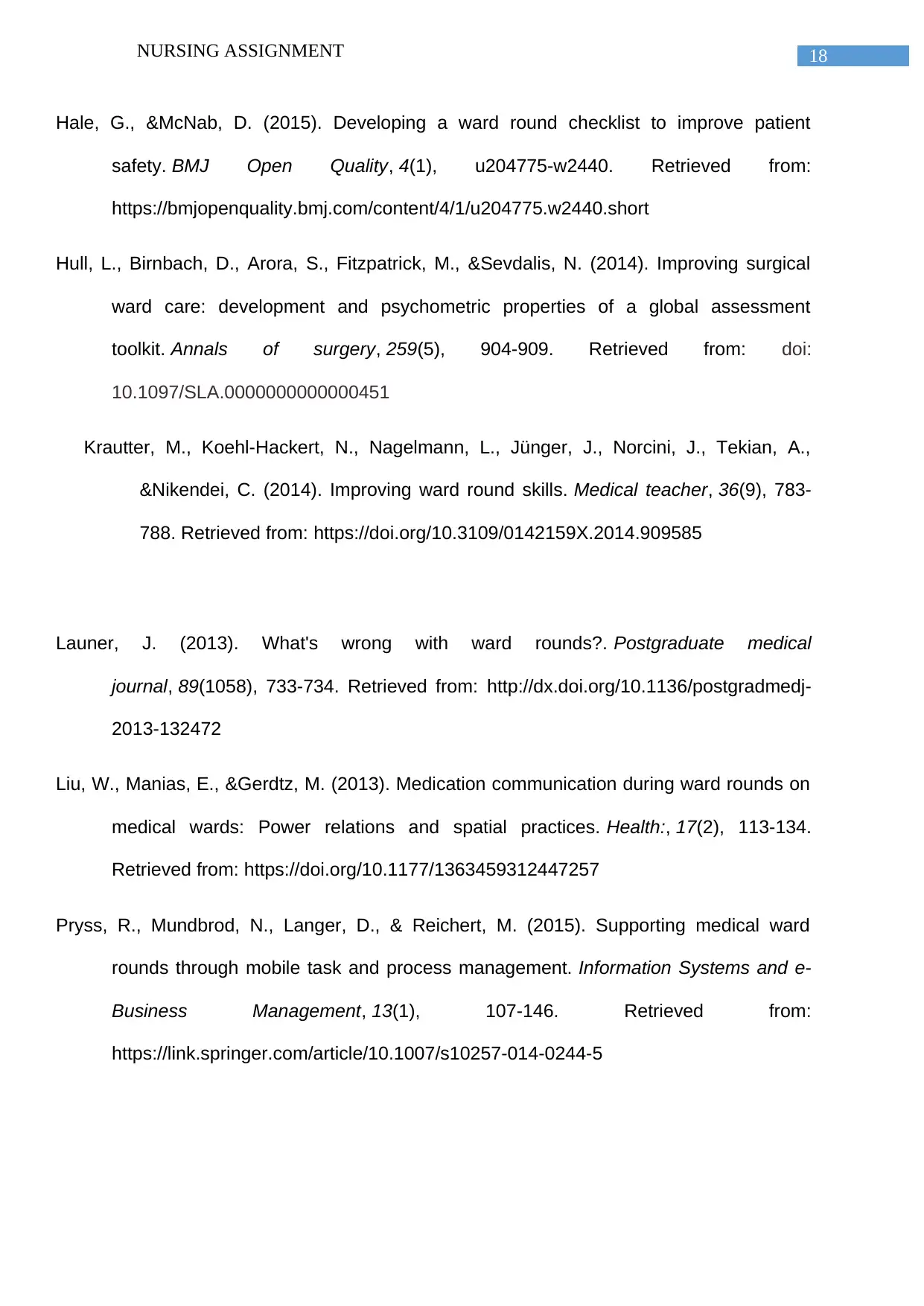
Hale, G., &McNab, D. (2015). Developing a ward round checklist to improve patient
safety. BMJ Open Quality, 4(1), u204775-w2440. Retrieved from:
https://bmjopenquality.bmj.com/content/4/1/u204775.w2440.short
Hull, L., Birnbach, D., Arora, S., Fitzpatrick, M., &Sevdalis, N. (2014). Improving surgical
ward care: development and psychometric properties of a global assessment
toolkit. Annals of surgery, 259(5), 904-909. Retrieved from: doi:
10.1097/SLA.0000000000000451
Krautter, M., Koehl-Hackert, N., Nagelmann, L., Jünger, J., Norcini, J., Tekian, A.,
&Nikendei, C. (2014). Improving ward round skills. Medical teacher, 36(9), 783-
788. Retrieved from: https://doi.org/10.3109/0142159X.2014.909585
Launer, J. (2013). What's wrong with ward rounds?. Postgraduate medical
journal, 89(1058), 733-734. Retrieved from: http://dx.doi.org/10.1136/postgradmedj-
2013-132472
Liu, W., Manias, E., &Gerdtz, M. (2013). Medication communication during ward rounds on
medical wards: Power relations and spatial practices. Health:, 17(2), 113-134.
Retrieved from: https://doi.org/10.1177/1363459312447257
Pryss, R., Mundbrod, N., Langer, D., & Reichert, M. (2015). Supporting medical ward
rounds through mobile task and process management. Information Systems and e-
Business Management, 13(1), 107-146. Retrieved from:
https://link.springer.com/article/10.1007/s10257-014-0244-5
Paraphrase This Document
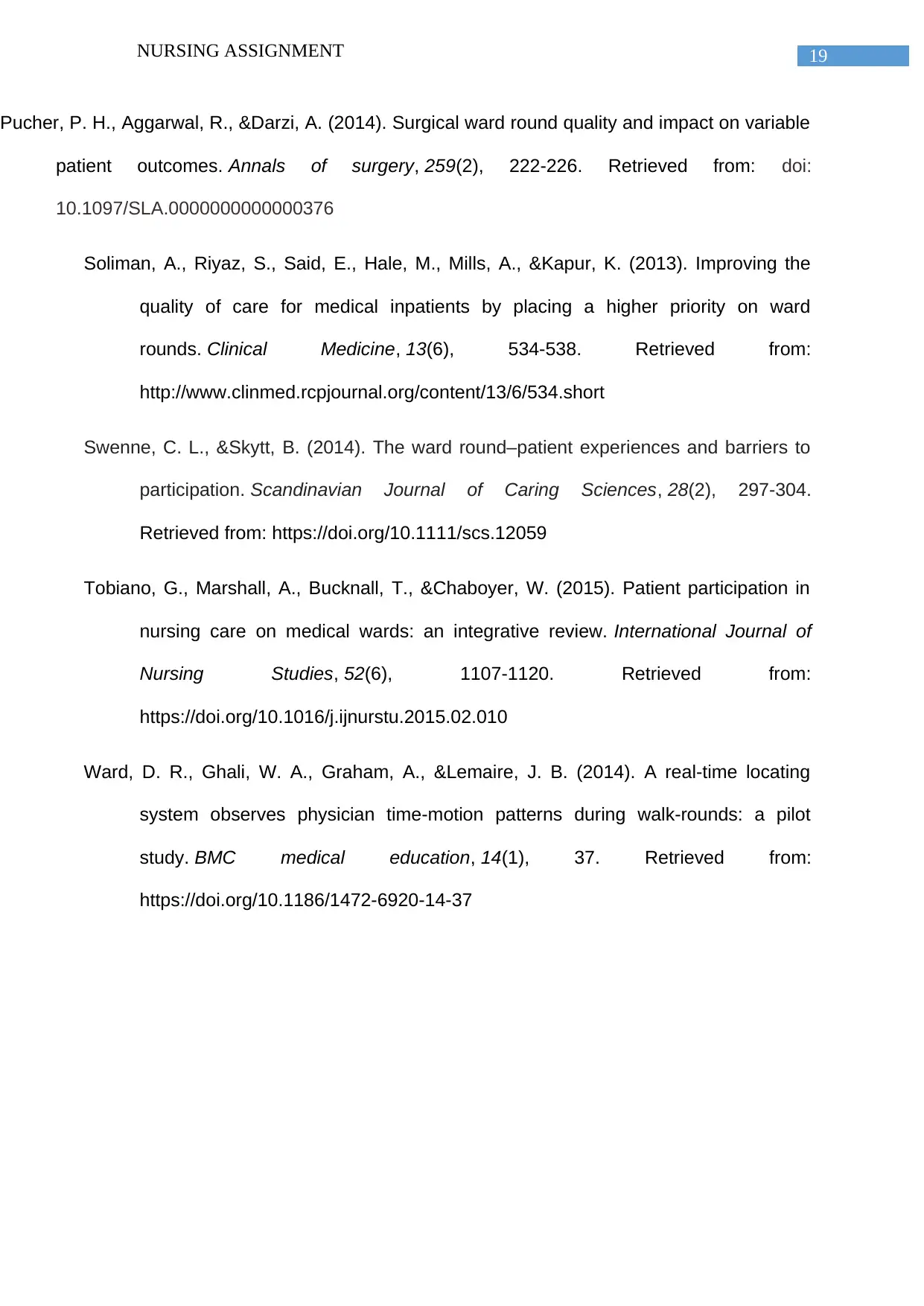
Pucher, P. H., Aggarwal, R., &Darzi, A. (2014). Surgical ward round quality and impact on variable
patient outcomes. Annals of surgery, 259(2), 222-226. Retrieved from: doi:
10.1097/SLA.0000000000000376
Soliman, A., Riyaz, S., Said, E., Hale, M., Mills, A., &Kapur, K. (2013). Improving the
quality of care for medical inpatients by placing a higher priority on ward
rounds. Clinical Medicine, 13(6), 534-538. Retrieved from:
http://www.clinmed.rcpjournal.org/content/13/6/534.short
Swenne, C. L., &Skytt, B. (2014). The ward round–patient experiences and barriers to
participation. Scandinavian Journal of Caring Sciences, 28(2), 297-304.
Retrieved from: https://doi.org/10.1111/scs.12059
Tobiano, G., Marshall, A., Bucknall, T., &Chaboyer, W. (2015). Patient participation in
nursing care on medical wards: an integrative review. International Journal of
Nursing Studies, 52(6), 1107-1120. Retrieved from:
https://doi.org/10.1016/j.ijnurstu.2015.02.010
Ward, D. R., Ghali, W. A., Graham, A., &Lemaire, J. B. (2014). A real-time locating
system observes physician time-motion patterns during walk-rounds: a pilot
study. BMC medical education, 14(1), 37. Retrieved from:
https://doi.org/10.1186/1472-6920-14-37

⊘ This is a preview!⊘
Do you want full access?
Subscribe today to unlock all pages.

Trusted by 1+ million students worldwide
Related Documents
Your All-in-One AI-Powered Toolkit for Academic Success.
+13062052269
info@desklib.com
Available 24*7 on WhatsApp / Email
![[object Object]](/_next/static/media/star-bottom.7253800d.svg)
© 2024 | Zucol Services PVT LTD | All rights reserved.





